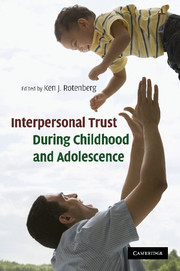Book contents
- Frontmatter
- Contents
- List of figures
- List of tables
- List of contributors
- Section I Conceptual foundations and issues
- Section II Childhood
- 5 Young children's trust in what other people say
- 6 Social relation and mutual influence analyses of children's interpersonal trust
- 7 Siblings and trust
- 8 The role of promises for children's trustworthiness and honesty
- 9 Liar liar! Pants on fire: Detecting the trustworthiness of children's statements
- Section III Adolescence and early adulthood
- Index
- References
7 - Siblings and trust
Published online by Cambridge University Press: 04 August 2010
- Frontmatter
- Contents
- List of figures
- List of tables
- List of contributors
- Section I Conceptual foundations and issues
- Section II Childhood
- 5 Young children's trust in what other people say
- 6 Social relation and mutual influence analyses of children's interpersonal trust
- 7 Siblings and trust
- 8 The role of promises for children's trustworthiness and honesty
- 9 Liar liar! Pants on fire: Detecting the trustworthiness of children's statements
- Section III Adolescence and early adulthood
- Index
- References
Summary
Developmental psychologist Judy Dunn (1996) called the sibling relationship “the first society.” This is because many children first attempt to protect their territory, justify their actions, and negotiate deals in the context of this relationship. Given what is at stake – love, protection, toys – it is, perhaps, not surprising that books for parents about reducing sibling rivalry and sibling conflict are popular (e.g., Brazelton and Sparrow, 2005; Faber and Mazlish, 2004). Sibling research, however, shows that siblings can also be sources of social support for individuals, particularly for children who are experiencing problems with their parents or peers (e.g., East and Rook, 1992; Milevsky and Levitt, 2005), and for adults who are widowed or childless (e.g., Doherty and Feeney, 2004; Guiaux, van Tilburg, and van Groenou, 2007). Furthermore, many children and teenagers report warm and intimate relationships with their siblings, especially with their sisters (e.g., Brody, 1998; Buhrmester and Furman, 1987, 1990; Dunn and McGuire, 1992; McGuire, McHale, and Updegraff, 1996; Noller, 2005). In fact, Howe and colleagues have found links between sibling warmth and relying on siblings as confidants, suggesting that a close sibling relationship may nurture the development of trust (Howe, Aquan-Assee, Bukowski, Lehoux, and Rinaldi, 2001; Howe, Aquan-Assee, Bukowski, Rinaldi, and Lehoux, 2000).
Interpersonal trust is a crucial component to positive relationships that foster healthy development (Rotenberg, 1991; Simpson, 2007).
- Type
- Chapter
- Information
- Interpersonal Trust during Childhood and Adolescence , pp. 133 - 154Publisher: Cambridge University PressPrint publication year: 2010
References
- 8
- Cited by



